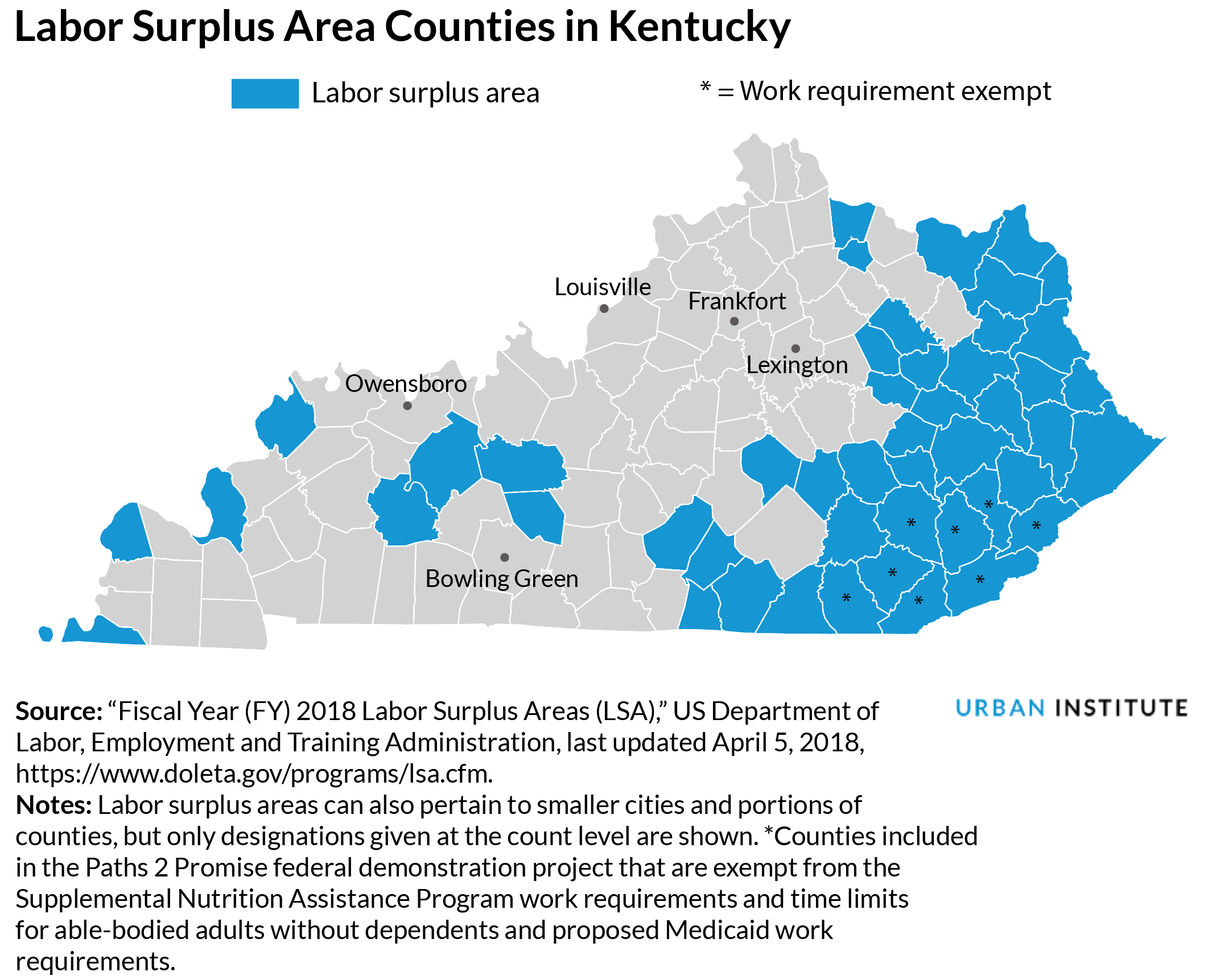
Kentucky has reinstated or seeks to introduce work requirements in two major social safety net programs: the Supplemental Nutrition Assistance Program (SNAP) and Medicaid.
Over the past several months, Kentucky has reinstated SNAP work requirements and time limits for able-bodied adults without children in 112 of 120 counties, and earlier this year, it received federal approval of a waiver to require certain Medicaid enrollees to work but was blocked in June by a federal court. The judge ruled that the US Department of Health and Human Services had not adequately considered whether the waiver would violate Medicaid’s basic charge of providing health care to low-income Americans.
In response to the court order, the federal government opened a public comment period on Kentucky’s waiver that ends August 18 to determine how work requirements might affect the program’s coverage objective.
In three maps of the state, we show how residents seeking work in certain geographical areas are more likely to face limited employment opportunities. In a figure, we show that black and Hispanic residents and those with limited educational attainment may also face greater challenges in Kentucky’s labor market. If people face challenges in finding stable work, work requirements might not facilitate work but instead penalize people for the absence of opportunity.
1. Many areas have high unemployment rates
Although the national economy has been improving, not all areas have benefited equally. In June 2018, Kentucky’s statewide, non–seasonally adjusted unemployment rate was 5.0 percent. But the rates across counties varied significantly, from 3.6 percent to 14.9 percent.
Twenty-two counties where SNAP time limits have been reinstated have unemployment rates above 7 percent. As the map demonstrates, if Kentuckians need to look for work or find a job with more hours, their prospects will vary depending on where they live.

2. Many areas have more job seekers than available jobs
Although a snapshot of the unemployment rate in a given month provides useful information, understanding the persistence of higher-than-average unemployment rates over time in the same location offers additional clues about the resilience of local labor markets.
The US Department of Labor uses labor surplus areas (LSAs) to flag specific geographies where the civilian average annual unemployment rate is 20 percent or higher than the average annual civilian unemployment rate for all states during the prior two years. Counties with an LSA designation are areas where there is a consistent lack of available jobs for people seeking work.
As of December 2016, the time period with the latest data available, there were 48 LSA counties in Kentucky, and 40 have reinstated SNAP time limits or are included in the Medicaid work requirement proposal.

3. Many counties suffer from persistent poverty
We can also look at areas with persistent poverty, which the US Department of Agriculture defines as areas where 20 percent or more of the population has lived in poverty over the past 30 years according to census data. Persistent poverty counties indicate areas suffering from long-term economic disadvantage that likely requires more attention, investment, and care than a reinstatement of work requirements.
Forty-three of 395 such counties across the United States (excluding Puerto Rico) are in Kentucky, many in the eastern part of the state.

4. Even counties with low unemployment rates have residents who struggle to access opportunities
Although these maps suggest that economic challenges in Kentucky are more pronounced in rural areas, employment opportunities within Kentucky’s more urbanized areas are unevenly distributed among residents. For example, there are significant variations in unemployment by race or ethnicity and educational attainment.
According to Census Bureau estimates, unemployment rates among African Americans and Hispanics in Kentucky in 2016 were 9.3 percent and 7.0 percent, respectively, compared with 5.6 percent for whites.
Jefferson County—Kentucky’s most-populous county—is also home to the largest nonwhite population. A 2016 report showed that at 7.4 percent, the nonwhite unemployment rate in Jefferson County was almost 70 percent higher than the county’s total unemployment rate, 4.4 percent.
In Kentucky’s five most-populous counties, unemployment rates for nonwhites were, on average, 1.5 times higher than for the overall population.
Securing employment opportunity will also be more challenging for job seekers with lower educational attainment. In 2016, statewide unemployment rates among residents with a high school diploma and those with less than a high school diploma were 6.1 percent and 10.1 percent, respectively, compared with 4.7 percent among those who had attended at least some college.

Imbalances between people looking for work and local labor market realities exist in every state. Helping people reach self-sufficiency is complicated, and work requirements cannot wish the availability of sufficient work into existence. A thorough understanding of underlying economic opportunities, barriers to employment, and the supports people need to overcome them are necessary to move people to self-sufficiency.
Let’s build a future where everyone, everywhere has the opportunity and power to thrive
Urban is more determined than ever to partner with changemakers to unlock opportunities that give people across the country a fair shot at reaching their fullest potential. Invest in Urban to power this type of work.